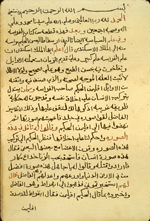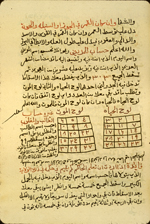Catalogue: Physiognomy
-
 Kitāb Sirr al-asrār (MS A 57)
Kitāb Sirr al-asrār (MS A 57) - (The Secret of Secrets)
- كتاب سر السرار
- attributed to Aristotle
- ارسطاطاليس الحكيم
The origins of the treatise are uncertain. No Greek original exists, though there are claims in the Arabic treatise that it was translated from the Greek into Syriac and from Syriac into Arabic by a well-known 9th-century translator, Yahyá ibn Bitriq. It appears, however, that the treatise was actually composed in Arabic. We can with certainty say that the section on physiognomy was circulating in Arabic before AD 940, for there is a manuscript now in the British Library (OIOC, MS Or. 12070) copied in 941/330 by one Muḥammad ibn ‘Alī ibn Durustawayh of Isfahan which contains this particular fragment of the treatise, though it is not called Sirr al-asrār. It antedates all references to the Sirr al-asrār (Secret of Secrets) and is earlier than all other known manuscript copies. It is likely that the treatise now known as The Secret of Secrets gradually evolved over a long period through the accretion of material on a wide range of topics, including statecraft, ethics, physiognomy, astrology, alchemy, magic, and medicine. A Latin translation of the Secret of Secrets from the Arabic was made in the mid-12th century by Joannes Hispalensis (preserved in some 150 copies) and again in the first half of the 13th century by Philippus Tripolitanus (preserved in more than 350 copies). It was extremely influential in Europe, where it was known as the Secretum secretorum and formed the basis of subsequent translations into Czech, Croatian, German, Icelandic, English, Castilian, Catalan, Portuguese, French, and Italian. It was also translated from the Arabic into Hebrew and then into Russian.
The Arabic treatise is preserved in two forms: a long version of 10 books and a short version of 7 or 8 books, preserved in a total of about fifty copies. The present manuscript represents one section from the long version. This portion is equivalent to the text found on p. 116, line 17, to p. 124, line, 3, of the edition of the 10-book version of Sirr al-asrār prepared by ‘Abd al Rahman Badawi, Al-Usul al-yunaniyah li-nazariyat al-siyasiyah fī al-islam (Dirasat islamiyah, 15), Cairo 1954.
For further discussion of the pseudo-Aristotelian Sirr al-asrar, see: Grignaschi, M., 'L'Origine et les metamorphoses du "Sirr al-asrar"', Archives d'histoire doctrinale et littéraire du Moyen Âge, vol. 43 (1976), pp. 7-112; Grignaschi, M., 'La Diffusion du "Secretum Secretorum" (Sirr al-asrar) dans l'Europe occidentale', Archives d'histoire doctrinale et littéraire du Moyen Âge, vol. 47 (1980), pp. 7-70; and Mahmoud Manzalaoui, 'The Pseudo-Aristotelian Kitāb Sirr al-asrār: Facts and Problems', Oriens, vol. 23-24, 1974, pp. 146-257.
The treatise Kitāb Sirr al-asrār attributed to Aristotle is distinctly different from a treatise on physiognomy with the title Kitāb fi al-firāsah attributed to Aristotle and said to have been translated into Arabic in the 9th century by Ḥunayn ibn Isḥāq. For the latter treatise, see Antonella Ghersetti, 'Il Kitab Arsitatalis al-faylasuf fi l-firasa' nella traduzione di Hunayn b Ishaq [Quaderni di Studi Arabi. Studi e testi, 4] (Venice: Herder Editrice,1999).
For other copies of Kitāb Sirr al-asrār, see Mahmoud Manzalaoui, 'The Pseudo-Aristotelian Kitāb Sirr al-asrār: Facts and Problems', Oriens, vol. 23-24, 1974, pp. 146-257.
Kitāb Sirr al-asrār (MS A 57)
Illustrations
The beginning of a portion of Kitāb Sirr al-asrār (The Secret of Secrets) falsely attributed to Aristotle. In lines 3-4 the treatise is called: Qit‘ah min kitab al-firasah wa-fi ‘ilm al-siyasah aydan (Extracts From the Book of Physiognomy and Also on the Art of Governing). The author is given as Aristatalis al-ḥakim (Aristotle the doctor), and it states that he wrote the treatise for Alexander the Great. The copy is dated on fol. 9b, line 12: Rajab 1264 [= 3 June-2 July 1848]. The copyist is not named.
Two charts for determining whether a person will live or die based on the numerical value of the patient's name. From copy of a portion of Kitāb Sirr al-asrār (The Secret of Secrets) falsely attributed to Aristotle. The copy is dated on fol. 9b, line 12: Rajab 1264 [= 3 June-2 July 1848]. The copyist is not named.
Physical Description
Arabic. 9 fols. (fols. 1a-9b). Dimensions 21 x 15.6 (text area 17 x 10.5) cm; 17-20 lines per page. The title is given on the title page (fol. 1a) as Fawa'id fi ‘ilm al-firāsah wa-ahwal al-nas (Useful Lessons in the Science of Physiognomy and the Conditions of Man). At the start of the text itself, the treatise is called (fol. 1b line 3?4): Qit‘ah min kitāb al-firāsah wa-fi ‘ilm al-siyasah aydan (Extracts from the Book of Physiognomy and Also on the Art of Governing). The author is given as Aristatalis al-ḥakim (Aristotle the doctor) on fol. 1b line 4, where it states that he wrote the treatise for Alexander the Great.
The copy is dated on fol. 9b, line 12: Rajab 1264 [= 3 June-2 July 1848]. The copyist is not named.
This is an extract from the pseudo-Aristotelian treatise usually known as Kitāb Sirr al-asrār (Secret of Secrets). This portion is equivalent to the text found on p. 116, line 17, to p. 124, line, 3, of the edition of the 10-book version of Sirr al-asrār prepared by ‘Abd al Raḥmān Badawi, Al-Usul al-yunaniyah li-nazariyat al-siyasiyah fi al-islam (Dirasat islamiyah, 15), Cairo 1954. The NLM copy was not used in the preparation of this edition.
The text is written in medium-large, rather stiff, naskh script using black ink with headings in red, some of which now have a silvery cast to them (possibly due to oxidation). The text area has been frame-ruled. There are catchwords.
The extracts are particularly concerned with diagnosis and prognosis of illness by divination using the numerical values of names, of lunar mansions, and of zodiacal signs. Fol. 7a has two charts for determining whether a person will live or die based on the numerical value of the patient's name.
The stiff beige paper has visible vertical laid lines and single chain lines and is watermarked. It is damp-stained near the edges.
The volume consists of 10 leaves. Fol. 10 is blank.
Binding
The volume is bound in a dark leather modern library binding. There are modern paper pastedowns and endpapers.
Provenance
The volume was purchased in 1941 by the Army Medical Library from A. S. Yahuda (ELS 1696 Med).
References
Schullian/Sommer, Cat. of incun. & MSS, entry A 57, p. 316. The title given by Sommer was taken from a recent owner's label pasted to front endpaper.
NLM Microfilm Reel: FILM 48-123 no. 4












